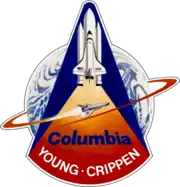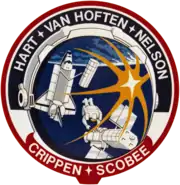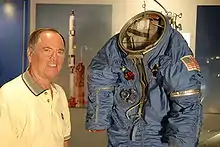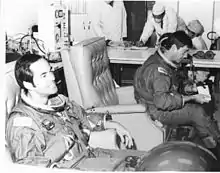Robert Crippen
Robert Laurel Crippen (born September 11, 1937) is an American retired naval officer and aviator, test pilot, aerospace engineer, and retired astronaut. He traveled into space four times: as Pilot of STS-1 in April 1981, the first Space Shuttle mission; and as Commander of STS-7 in June 1983, STS-41-C in April 1984, and STS-41-G in October 1984. He was also a part of the Manned Orbiting Laboratory, Skylab Medical Experiment Altitude Test, Apollo–Soyuz, and the Approach and Landing Tests for the Space Shuttle. He did not go to space for any of those programs.
Robert L. Crippen | |
|---|---|
 | |
| Born | September 11, 1937 |
| Status | Retired |
| Nationality | American |
| Other names | Robert Laurel Crippen |
| Alma mater | University of Texas at Austin, B.S. 1960 |
| Occupation | Naval aviator, test pilot |
| Awards | |
| Space career | |
| USAF / NASA Astronaut | |
| Rank | |
Time in space | 23d 13h 46m |
| Selection | 1966 USAF MOL Group 2 1969 NASA Group 7 |
| Missions | STS-1, STS-7, STS-41-C, STS-41-G |
Mission insignia |     |
| Retirement | December 31, 1991 |
In 1986, Crippen participated in the recovery operations for the remains of crew members after the Space Shuttle Challenger disaster.[1] He was also on the commissions responsible for determining the cause of the accident.
After retiring as an astronaut, Crippen worked his way through management at NASA, namely as Deputy Director at NASA Headquarters, then Director. He also went to Lockheed Martin and Thiokol Propulsion before retiring to private life in Florida.
Crippen has received several awards and honors, including the Congressional Space Medal of Honor in 2006, and having an elementary school named after him in Porter, Texas. He is also a member of several organizations, including the American Institute of Aeronautics and Astronautics and the Society of Experimental Test Pilots.
Early life and education
Robert Crippen was born in Beaumont, Texas on September 11, 1937.[2] After graduating from New Caney High School in New Caney, Texas in 1955, Crippen went to the University of Texas at Austin to major in Aerospace Engineering. In 1960, he graduated with his Bachelor of Science degree.[2][3][4] He was selected as a member of the Texas Alpha chapter of Tau Beta Pi and Sigma Gamma Tau.[5]
Crippen became interested in flying and computers at a very early age. He attended the first computer programming class held at the University of Texas. Throughout his career in the military and at NASA, he worked on computer programming, including programs such as the Manned Orbiting Laboratory, Skylab and the Space Shuttle.[6]
Military career
Crippen was commissioned through the United States Navy's Aviation Officer Candidate School (AOCS) Program at Naval Air Station Pensacola, Florida.[2] He also spent time at the Naval Air Station Whiting Field in Florida and the Naval Air Station Chase Field in Beeville, Texas. That is where he earned his wings. As a Naval Aviator from the summer of 1962 to the end of 1964, he made two deployments aboard the USS Independence, flying the A-4 Skyhawk in Attack Squadron 72 (VA-72). He later went to Edwards Air Force Base in California to attend the U.S. Air Force Aerospace Research Pilot School. After graduation, Crippen worked as an instructor at Edwards Air Force Base until October 1966 when he was picked for the U.S. Air Force's Manned Orbiting Laboratory (MOL) program.[2] He has spent more than 6,500 hours in the air as either a pilot or an astronaut.[3]
Manned Orbiting Laboratory

The Manned Orbiting Laboratory (MOL) program was a follow-on to the X-20 Dyna-Soar program. A joint program between the United States Air Force and the National Reconnaissance Office (NRO), the MOL program would send humans into space.[7]
Publicly, the MOL program was designed to determine the usefulness of man in space. Crews would be in orbit for about a month and they would be able to freely move about the laboratory.[8] The secret and primary mission was to perform reconnaissance missions on Russia and China. The pilots were not told of this true mission, though they were later informed.[9]
When Crippen was selected for astronaut training in October 1966, he had to choose between the military and NASA, deciding to stay in the military to work on the MOL program. He felt that he would get lost at NASA due to the number of astronauts already in programs at the agency. There was an uncrewed flight on November 3, 1966. There were no crewed flights. After the MOL program was cancelled, Crippen transferred to NASA to continue his career.[6]
The program was cancelled in June of 1969.[7] This was due to differing priorities within the military and space programs. The government decided to de-emphasize military involvement in the space program. However, developments like the space suit, waste management, and the high resolution camera were later used in various space programs going forward.[10]
NASA career
—Crippen's Shuttle experiences[11]
After the MOL program was cancelled, Crippen became part of NASA Astronaut Group 7 in September 1969.[2] He served as support for the Skylab 2, Skylab 3, and Skylab 4, as well as for the Apollo-Soyuz Test Project.[2]
Skylab Medical Experiment Altitude Test (SMEAT)
The Skylab Medical Experiment Altitude Test (SMEAT) was a 56-day mission (July 26 through September 19, 1972), where astronauts Crippen, Karol J. Bobko and William E. Thornton were housed in a vacuum chamber to conduct medical experiments. The goal was to ensure that crews in space could handle minor medical emergencies, including dentistry.[6]
SMEAT also was able to discover and fix the design flaws in the urine handling system for Skylab. [12] Crippen and the team worked to enlarge the original collection system design, which was too small, the collection system of which had burst at one point.[6]
Apollo-Soyuz Test Project
The Apollo-Soyuz test project was a joint effort between the United States and the Soviet Union, designed to test rendezvous and docking capabilities if there were ever an emergency in space. [13] Crippen was the capsule communicator (CAPCOM) for the Apollo-Soyuz project (as well as Skylab), during which time he developed a close association with Mission Ops and Flight Control. [6] On July 15, 1975, the United States launched a Saturn IB rocket in an Apollo configuration into space. Two days later, it docked with a Soyuz spacecraft. [13]
Approach and Landing Test (ALT)
The Approach and Landing tests for the Space Shuttle were critical to the overall program, in which a crew tested the maneuverability and landing capabilities of the spacecraft. Launched from a 747 aircraft, the prototype Space Shuttle Enterprise was first tested on August 12, 1977. Astronauts Fred Haise and C. Gordon Fullerton piloted the Enterprise from about 24,000 feet to the ground and landed at Edwards Air Force Base. A second crew of astronauts Joe Engle and Richard H. Truly alternated with Haise and Fullerton to test the Enterprise’s capabilities. [14] Crippen was first assigned to family support with the testing, then progressed to being a chase pilot in a T-38.[6] The ALT program lasted about a year, testing all aspects of approach and touchdown from aerodynamics to maneuverability, gliding and landing characteristics. [15]
STS-1

Crippen was the pilot on STS-1, the first test flight of the Space Shuttle in orbit. [16] His job involved working with the Shuttle computers, electrical systems, and auxiliary power units. He was also responsible for the operating the payload bay doors.[6] STS-1 had several firsts: a crewed vehicle to be flown into Earth orbit without any prior non-crewed orbital testing; a crewed, winged vehicle to launch with solid rocket boosters;[16] a reentry vehicle to land on a conventional runway. It launched April 12, 1981 and landed April 14, 1981.[17]
STS-7
Crippen served as the commander of STS-7, the second launch of the Space Shuttle Challenger, and headed a crew of five people. During flight, the team deployed the Canadian Anik (satellite) C-2 satellite, as well as the Palapa B-1 satellite from Indonesia. They also used the Canadian Remote Manipulator System (RMS) to deploy and retrieve the Shuttle Pallet Satellite (SPAS-01). They conducted formation flying with an untethered satellite (SPAS-02), operated a joint U.S.-German materials experiment (OSTA-2) and activated seven Getaway Special experiments. Finally, they worked with the Continuous Flow Electrophoresis System (CFES) and the Monodisperse Latex Reactor (MLR). It launched June 18, 1983 and landed June 24, 1983.
STS-41-C
Crippen was the commander on STS-41-C, a seven-day mission during which the crew deployed the Long Duration Exposure Facility (LDEF). The crew also retrieved, repaired and redeployed Solar_Maximum_Mission Satellite using the Canadarm. The flight also tested the Manned Maneuvering Units (MMU's) through two extravehicular activities (EVA). The team also operated the Cinema 360 and IMAX Camera Systems. Finally, the crew ran student experiment. It launched April 6, 1984 and landed April 13, 1984.
STS-41-G
On his final spaceflight, Crippen served as the commander of STS-41-G. During the eight-day flight, the crew deployed the Earth Radiation Budget Satellite. They also performed scientific observations of the Earth with a Large Format Camera, and demonstrated potential satellite refueling with the Orbital Refueling System (ORS). Finally, the Office of Space and Terrestrial Applications-3 (OSTA-3) also had experiments for the crew to perform. It launched October 5, 1984 and landed October 13, 1984 at Kennedy Space Center, Florida.[18]
Post-spaceflight career
After STS-41-G, Crippen was named Commander of the STS-62-A mission which would have launched from the new SLC-6 facility at Vandenberg Air Force Base, California. That mission was cancelled after the Space Shuttle Challenger disaster in 1986, and SLC-6 was closed when the Air Force went back to launching satellites on the Titan III and Titan IV rockets.
Crippen was a part of the Mishap Review Board to examine the cause of the Challenger accident, the recovery of the vehicle debris, and to find and return the remains of the crew. The Board became a sub-team for the Rogers Commission Report, the team put together by President Ronald Reagan to investigate the accident.[6]
Crippen was stationed at Kennedy Space Center (KSC) from July 1987 to December 1989. He was Deputy Director of Shuttle Operations under George Abbey (NASA). He was accountable for Shuttle missions and the return of the craft to KSC after landings at Edwards. He was also responsible for handling any issues when Abbey was not available.[6]
From January 1990 to January 1992, Crippen served as Director of the Space Shuttle program at NASA Headquarters. As such, he was responsible for the all aspects of the Shuttle program, including scheduling, budget and overall program management. His primary responsibility was to take the recommendations of the Rogers Commission and implement as many of them as possible. He was also responsible for looking at the management structure of NASA and to see what restructuring needed to be done.[6] Afterwards, he moved to KSC to become their Director. This lasted from January 1992 through to January 1995.
Post-NASA career
After leaving NASA, from April 1995 through November 1996, Crippen was the Vice President of Lockheed Martin Information Systems. His main focus was simulation work supporting the military.[6]
Crippen became President of Thiokol Propulsion from December 1996 through to April 2001. They were responsible for producing the Space Shuttle Reusable Solid Rocket Motors.[19] Crippen enjoyed continuing his connection with the Space Shuttle program. In particular, he appreciated his role in working to improve the design of the solid rocket boosters to prevent another Challenger disaster.[6]
Organizations
Crippen is a fellow in the American Institute of Aeronautics and Astronautics, the Society of Experimental Test Pilots, and the American Astronautical Society.[3] He served as President of the American Institute of Aeronautics and Astronautics in 1999.[20] He was selected to be a member of Naval Aviators Golden Eagles in 2009. He was elected to the National Academy of Engineering in 2012.[21]
Awards and honors
.JPG.webp)
Crippen's has earned several awards throughout his career, including the SETP Iven C. Kincheloe Award (1981)[22] and the NASA Exceptional Service Medal (1972). In 1981 after the inaugural Space Shuttle flight, he received the Department of Defense Distinguished Service Award, the American Astronautical Society's Flight Achievement Award, the National Geographic Society's Gardiner Greene Hubbard Medal, and the American Legion's Distinguished Service Medal. He was awarded the Federal Aviation Administration's Award for Distinguished Service (1982), the Dr. Robert H. Goddard Memorial Trophy and the Harmon Trophy. He received the Navy Distinguished Flying Cross (1984) and the Defense Meritorious Service Medal (1984).[23] Finally, Crippen received the Golden Plate Award of the American Academy of Achievement (1986).[24]
He also received NASA Outstanding Leadership Medal, four NASA Space Flight Medals, and three NASA Distinguished Service Medals. In 1996, Crippen became the tenth individual to receive the Rotary National Award for Space Achievement's National Space Trophy. He was inducted into the International Space Hall of Fame in 1991 and the U.S. Astronaut Hall of Fame in 2001.[11][25] On April 6, 2006, he received the Congressional Space Medal of Honor, the highest award for spaceflight achievement.[26]
On November 18, 2015, at the National Business Aviation Association convention in Las Vegas, Crippen was announced as a 2016 Inductee into the National Aviation Hall of Fame.[27]
Personal life
Crippen was first married to Virginia Hill on September 8, 1959. They had three daughters together: Ellen Marie (born June 1962), Susan Lynn (born December 1964), and Linda Ruth (born May 1967).[2] On November 7, 1987, he married Pandora Puckett, NASA's first female lead Orbiter Project Engineer on the Space Shuttle Atlantis and Challenger at the Kennedy Space Center.
See also
References
- "Chapter 6: Raising heroes from the sea". 25 January 2006.
- "Robert L. Crippen". New York Times. April 13, 1981. Retrieved January 21, 2018.
- "Robert Crippen NASA Biography" (PDF). NASA. July 2001. Retrieved January 16, 2021.
- Alumni Profile Robert L. Crippen, BS ASE 1960 – website of the University of Texas at Austin
- "Astronauts & Flight Scientists". Tau Beta Pi. Retrieved February 13, 2018.
- "NASA Johnson Space Center Oral History Project: Robert L. Crippen". NASA. 26 May 2006. Retrieved December 30, 2019.
- "Manned Orbiting Laboratory Declassified Photos". Space.com. 4 March 2017. Retrieved December 21, 2020.
- "The DORIAN Files Revealed: A Compendium of the NRO's Manned Orbiting Laboratory Documents" (PDF). National Reconnaissance Office. 1 August 2015. Retrieved December 20, 2020.
- "Biography Albert H. Crews" (PDF). Kenneth R. Crippen. 4 January 2020. Retrieved December 20, 2020.
- "The Air Force's Space Program MOL". Apoll011Space. 1 August 2020. Retrieved December 24, 2020.
- "Piloted the first space shuttle". New Mexico Museum of Space History. Retrieved December 31, 2017.
- "SMEAT-Space Patches". A-B Emblem. 21 December 2020. Retrieved December 21, 2020.
- "Apollo-Soyuz Test Project Overview". NASA. 3 August 2017. Retrieved December 21, 2020.
- "Enterprise: The Test Shuttle". Space.com. 9 October 2012. Retrieved December 21, 2020.
- "Space Shuttle Approach and Landing Tests (ALT)". NASA. 7 February 2013. Retrieved December 21, 2020.
- "Flying Machine". Star-Gazette. April 15, 1982. p. 9 – via Newspapers.com.
- "STS-1 Overview". NASA. Retrieved 22 August 2010.
- "41-G (13)". NASA. Retrieved February 13, 2018.
- "CRIPPEN JOINS THIOKOL AS ITS PRESIDENT". Deseret News. October 22, 1996. Retrieved December 31, 2017.
- "AIAA Leadership". AIAA. Retrieved February 13, 2018.
- "Alumnus Bob Crippen Elected to National Academy of Engineering". February 27, 2012. Retrieved February 13, 2018.
- "Iven C Kincheloe Recipients". Society of Experimental Test Pilots. Retrieved January 22, 2018.
- "Robert L. Crippen CAPT USN (Ret.)" (PDF). The Golden Eagles. Retrieved February 13, 2018.
- "Golden Plate Awardees of the American Academy of Achievement". www.achievement.org. American Academy of Achievement.
- "Robert Crippen". Astronaut Scholarship Foundation. Retrieved December 31, 2017.
- "First Shuttle Pilot Crippen Gets Congressional Space Medal of Honor". NASA. April 27, 2006. Retrieved December 31, 2017.
- "Robert Crippen". The National Aviation Hall of Fame. Retrieved December 31, 2017.
External links
| Wikimedia Commons has media related to Robert Crippen. |